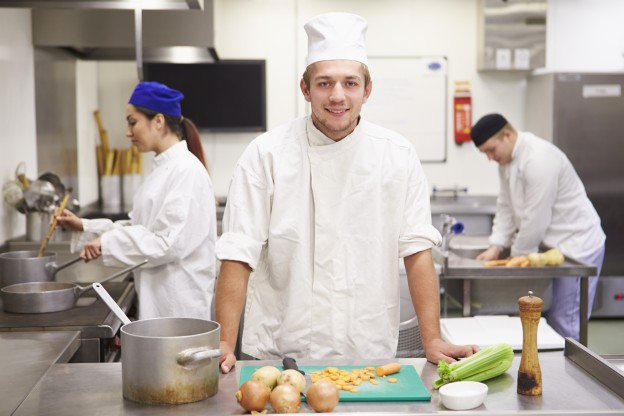Cruise ship jobs are enviable thanks to the appealing hierarchy and remuneration that comes with being at the top. It’s a long tough road to heading a cruise ship kitchen, but the skills learnt, the volumes handled and competencies acquired can eventually put you up for grabs even in a shore-based job.
There are many who start their careers on cruise lines without any formal qualification in hospitality. Dishwashers, galley stewards and crew messmen require no experience or hospitality education, perhaps just minimal English language skills. Galleys – or kitchens on cruise ships – also have storekeepers, an assistant and a supervisor, who are responsible for ordering, distribution and storage of food supplies. They require a background in food and beverage, and accounting.
The first main level in a cruise ship kitchen with educational qualifications in hospitality is a cook trainee. In the pastry and bakery departments, this level is filled by the pastry trainee and baker trainee respectively.
Trainee cooks go on to become commis. On large ships, this level is divided into commis 3, 2 and 1; or third cook, second cook and first cook. Commis 3 or third cooks follow the directions of their superiors. They generally organise, prepare, measure and mix various ingredients at the base level – such as washing, peeling, cutting and shredding vegetables; butchering and trimming meat, etc. Major cruise lines require a few years of experience in a four or five star hotel to reach this level. The commis 2 or second cook, and commis 1 or first cook oversee those in the levels below them and jump on board whenever there is a rush.
With experience, you can become a demi chef de partie, who assists the sous chef in operations. Demi chefs are usually assigned to a particular station – fish, sauces, vegetables, soups, etc. They are also known as station chefs or line cooks, and prepare and present dishes based on their speciality. While they are still sometimes involved in prep stages, particularly during rush hour, there is a good chance to work closely with the head chef and learn from him or her.
At the senior level is the chef de partie, who specialises in gourmet cuisine and specialties. At this level, management becomes increasingly important and a supervisory role is common. Chefs de partie regularly review requirements and time frames with the sous chef, assigns tasks and supervises the functioning of his or her particular station. Many entry level cooks receive training and mentoring from the chef de partie with regards to proper service and plating.
Further up is the sous chef, who handles the daily operations of the galley staff and liaises with the head chef or executive chef with planning and quality control. There are evaluations of employees, finances, reports, training programmes, and quality control to be done, all of which are often conducted by the sous chef.
Some large cruise companies also have an executive sous chef as another layer of management within the system. All the lower rung hierarchy in the main kitchen is replicated in the pastry and bakery divisions, with bakers, assistant baker supervisors, baker supervisors; and pastry chefs, assistant pastry chef supervisors and pastry chef supervisors. Leading their section is the cruise ship pastry chef.
At the helm of affairs in a cruise ship kitchen is the executive chef or chef de cuisine, who takes on the final responsibility for all that goes on in the galley and among staff. He or she directs the menu, culinary activities and oversees the functioning of the kitchen that supplies thousands of cruise vacationers their meals and delicious treats.


